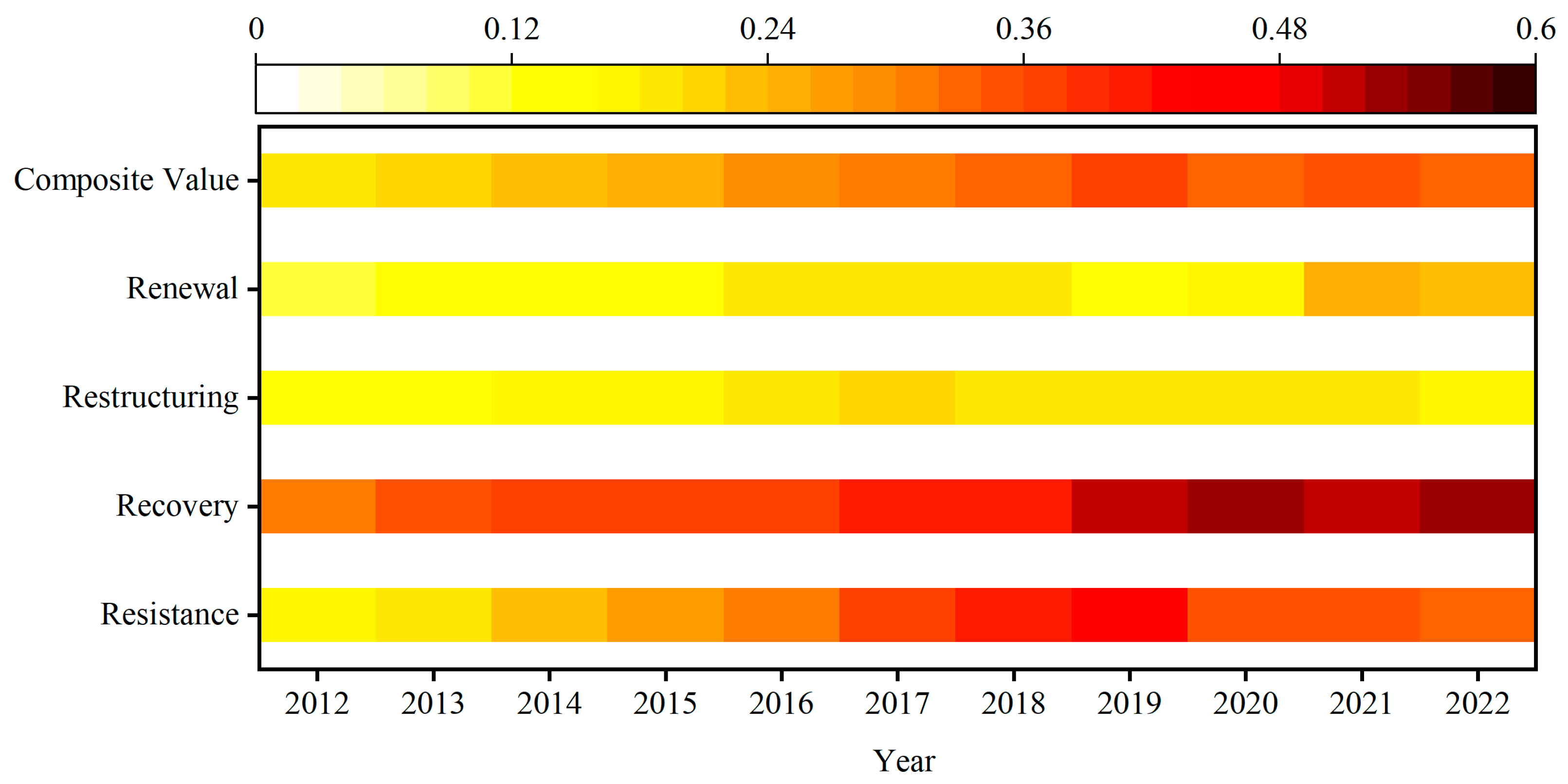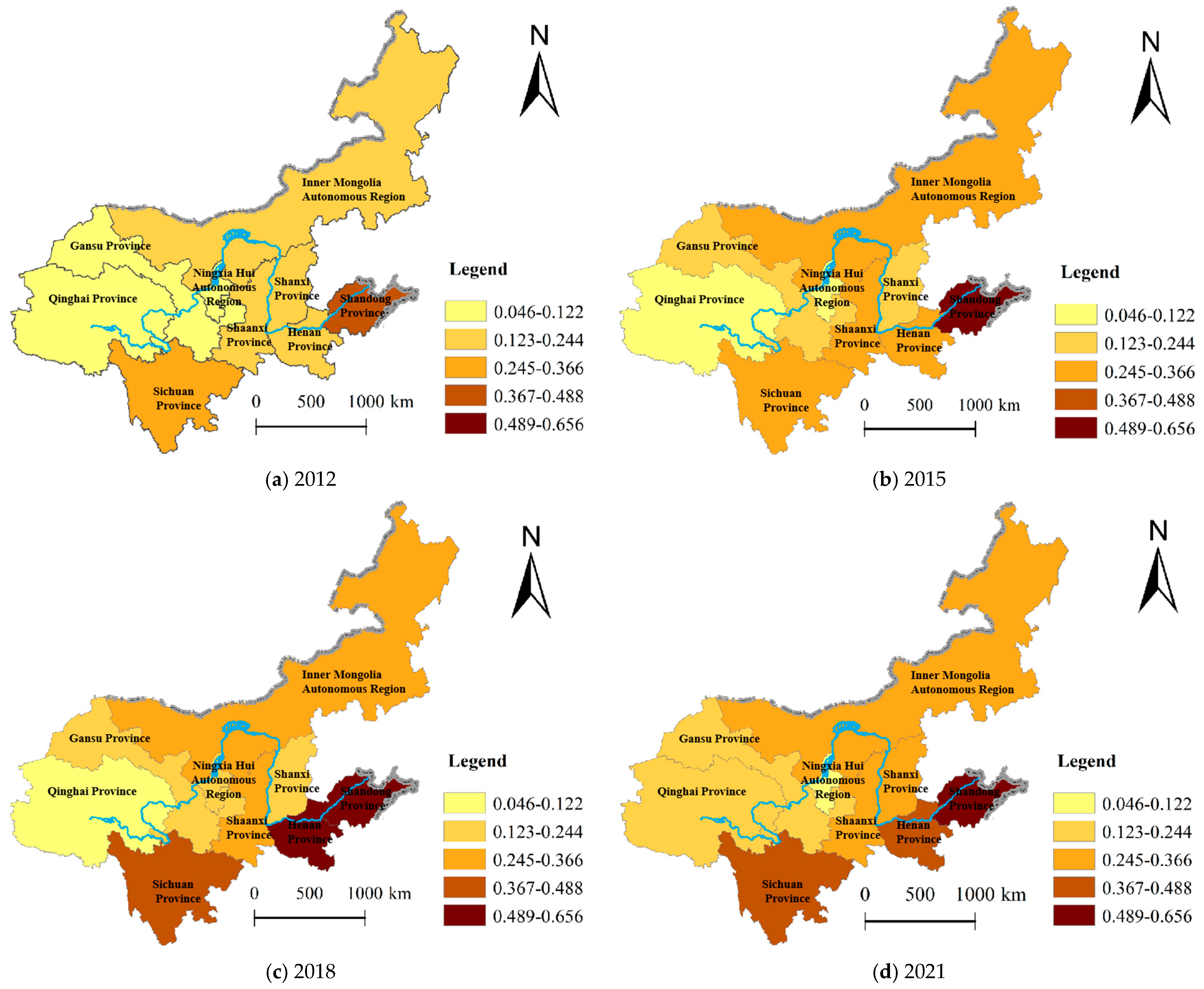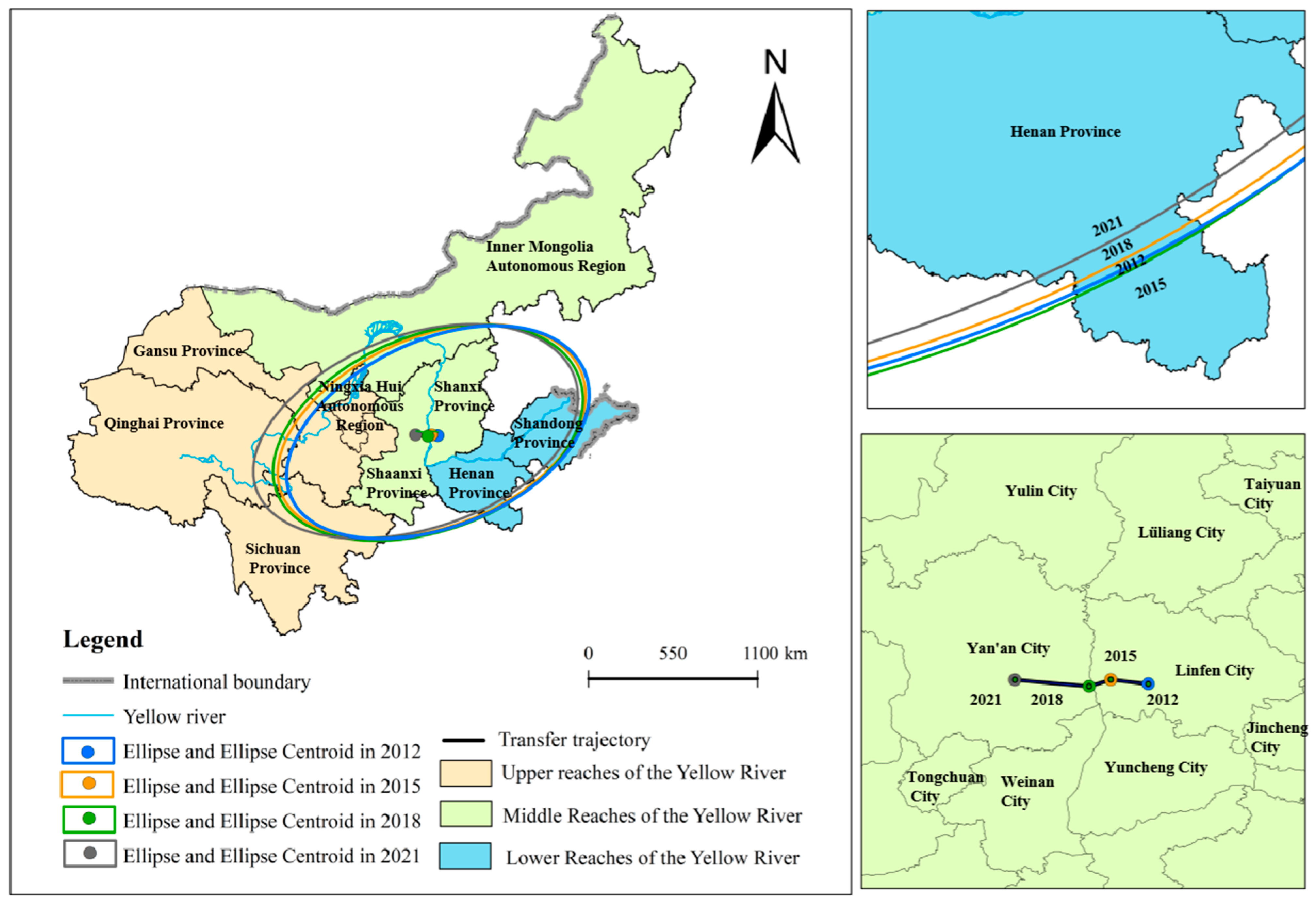4.2.2. Sufficiency Analysis
To test sufficiency, truth-tables was constructed with a frequency threshold of 1 and an initial consistency threshold of 0.7. The truth tables for the 2012 tourism economy under high-resilience and non-high-resilience condition combinations are presented in
Table A1 and
Table A2 of the
Appendix A. Truth tables for other years may be obtained from the authors to support research reproducibility. The intermediate solution was taken as the standard, and any condition present in both the parsimonious and intermediate solutions was designated as a core condition, while others were treated as auxiliary. To ensure robustness, the original calibration anchors were reset to the 90th, 50th, and 10th percentiles, and the consistency threshold was raised to 0.75 [
32]. Re-estimation produced no substantive change in the core conditions, confirming the reliability of the results.
Nine configurational pathways that generate high TER are reported in
Table 5. Both individual and overall solution consistencies exceed 0.8, attesting to the reliability of the findings. These pathways are hereafter termed “driving paths,” which can be synthesised into four archetypes.
- (1)
Resistance-dominated Path
The “Resistance-dominated” path refers to addressing external shocks and internal pressures faced by the tourism economy by enhancing resilience. This model includes Pathways Config. 1, Config. 2, and Config. 6, all of which rely on strong resilience as a core condition. A typical example of Config. 1 is Henan Province in 2012. The provincial government launched and implemented a series of measures, including the “Cultural Henan” tourism brand enhancement project and the optimization of tourism infrastructure, significantly increasing tourists’ interest and participation in tourism, fully demonstrating the positive role of the resistance-dominated path. Config. 6 is exemplified by Shaanxi Province in 2018, which proposed and implemented policies such as upgrading the cultural and tourism welfare electronic card and expanding cultural and tourism consumption credit services. These measures enhanced tourists’ willingness and ability to consume, thereby mitigating the negative impacts of market fluctuations to some extent, demonstrating the effectiveness of resistance-dominated pathways in maintaining the stability of the tourism economy.
- (2)
Recovery-dominated with Restructuring Synergy Path
The “Recovery-dominated with Restructuring Synergy” path refers to the tourism economy facing risks and challenges, with resilience as the core driving force and reconstruction playing a synergistic role, jointly promoting the rapid recovery and resilience enhancement of the tourism economy. This model includes Config. 5 and Config. 9, both of which take resilience as the core condition and reconstruction as the auxiliary condition. A typical example of Config. 5 is Henan Province in 2015. Despite suffering from natural disasters in 2015, the province’s tourism industry quickly regained vitality thanks to efficient disaster response and recovery strategies. Affected areas swiftly advanced scenic area repairs to ensure safe and comfortable tourist experiences. Additionally, Henan Province increased investment in tourism infrastructure to further improve tourism service quality, thereby strengthening the reconstruction capacity of its tourism economy. A typical example of Config. 9 is Ningxia Province in 2021. Facing pandemic risks, the province swiftly adjusted its tourism strategies, implementing measures such as “limited capacity, reservations, and peak-spreading” to effectively stabilize the tourism market order, ensure the continuous operation of the tourism industry chain, and achieve the comprehensive recovery and enhanced resilience of its tourism economy.
The “Renewal-Driven” path refers to a strategy that relies on strong renewal capacity, which enhances adaptability and resilience through continuous innovation, transformation, and upgrading. The paths included in this category are Config. 3 and Config. 7, both of which regard renewal capacity as a core condition. Config. 3 indicates that even in the absence of resistance and restructuring capabilities, high renewal capacity alone can achieve high resilience in the tourism economy. This path is commonly found in regions that prioritize tourism product innovation but have relatively stable industrial structures. A typical example is Shandong Province in 2012, which leveraged the “Hospitality Shandong” brand to deeply explore and promote local characteristics, effectively enhancing the tourism economy’s renewal capacity. In 2021, Henan Province, leveraging its rich cultural heritage, continuously innovated tourism products and services, launching the “night tourism economy” project to enhance the tourism economy’s adaptability and vitality. Config. 7 emphasizes the synergistic effect of high renewal capacity as the core, coupled with high restructuring capacity. A typical example of Config. 7 is Inner Mongolia Autonomous Region in 2018 which actively implemented diversified innovations in tourism products, such as in-depth grassland cultural tours and self-driving tours, to enrich the tourism market supply. Simultaneously, it leveraged the upgrading of tourism infrastructure and the establishment of smart tourism platforms to stabilize the tourism industry chain, thereby ensuring high-quality and efficient tourism services.
- (4)
Multi-Resilience Synergy-Driven Path
The “Multi-Resilience Synergy-Driven” path denotes the promotion of steady growth in the tourism economy through the synergistic effect of resistance, rapid recovery, flexible restructuring, and continuous renewal capabilities. The core pathways of this model include Config. 4 and Config. 8. Config. 4 takes resistance, restructuring, and renewal as auxiliary conditions. A typical example is Sichuan Province in 2015, which swiftly activated emergency response measures in the face of natural disasters, such as conducting safety assessments and repairs after the Jiuzhaigou earthquake. Simultaneously, it optimized traditional tourism projects, initiated the development of rural tourism, and advanced smart tourism (e.g., the launch of the “Sichuan Tourism” app), demonstrating the application of renewal capabilities and facilitating the high-resilience development of Sichuan’s tourism economy. Config. 8 regards recovery as the key driving force, with resistance, restructuring, and renewal serving as the supporting system. A typical case of this pathway is Shanxi Province in 2021, which deeply explored the cultural connotations of “Yellow River Culture” and “Taihang Spirit.” Through policies such as issuing government consumption vouchers and extending the reimbursement period for provincial subsidy funds, strong guarantees have been provided for the recovery and resilient growth of the tourism economy. This achieved a virtuous cycle from recovery to restructuring, and then to continuous renewal, comprehensively enhancing the overall resilience.
As reported in
Table 6, nine limiting configurations—hereafter “constraint pathways”—are identified for the nine-province Yellow River corridor. Both individual- and overall-solution consistencies exceed 0.80, attesting to the robustness of the results. These pathways can be synthesised into three archetypes.
First, the “Renewal-Constrained” path (Config. 10, Config. 11, Config. 17, Config. 18) refers to tourism economies that face bottlenecks in resilience development due to a lack of renewal capacity. This makes it difficult to introduce new technologies, products, and service models, results in slow recovery from shocks, and constrains long-term resilience development. A typical case of Config. 17 is Inner Mongolia Autonomous Region in 2021, where fluctuations in income levels and an incomplete social security system exacerbated the outflow of tourism talent, leading to a shortage of professional personnel. Additionally, the lag in technological development significantly hindered the construction of a smart tourism system, resulting in insufficient intelligence and convenience in tourism services, a decline in visitor experience quality, and ultimately an adverse effect on the overall resilience. These issues highlight the shortcomings of Inner Mongolia’s tourism industry in human resource allocation and technological innovation application, necessitating improvements through policy guidance and resource investment.
Secondly, the “Restructuring-Lagged” path (Config. 12, Config. 13, Config. 15) refers to the tourism economy’s lack of flexible strategies in response to environmental changes. When faced with market fluctuations, shifts in consumer preferences, and the impact of new technologies, the system reacts slowly, leading to reduced competitiveness and an inability to adapt to future trends, thereby limiting the enhancement of TER. A typical case of Config. 12 is Shanxi Province in 2012, where the restructuring capacity for TER was constrained by a shortage of tourism practitioners—resulting in declining service quality—and limited investment, which hindered the effective development of tourism resources.
Finally, the “Overall Resilience-Deficient” path (Config. 14, Config. 16) refers to a comprehensive lack of all four key capabilities (resistance, recovery, restructuring, and renewal), resulting in a fragile system. Such systems require strengthening in multiple areas, including infrastructure, innovation capacity, and industrial structure, to comprehensively enhance TER. A typical case of Config. 14 can be referenced from Gansu Province in 2015, where the relative lag in infrastructure and the singularity of the industry structure constituted the primary constraints on the diversified development of Gansu. In the face of fluctuations in the market environment and adjustments in policy orientation, these limitations significantly weakened the self-recovery and adaptability of Gansu’s tourism industry.








